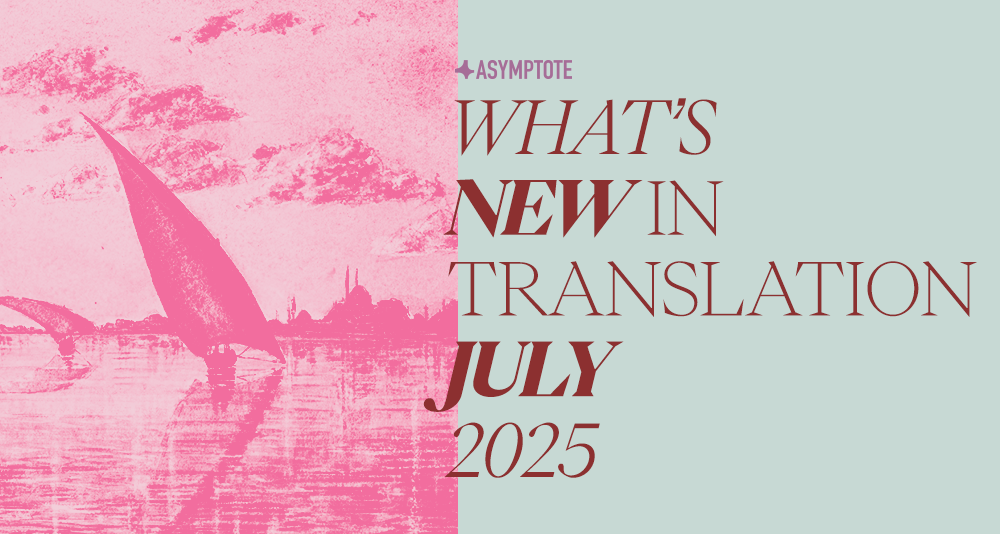This month, we’re delighted to present eleven titles from eleven countries, including a lyrical litany of dreams from a Nobel laureate, a psychologically thrilling fiction-study of domestic violence and complicity, a rollicking novel on poverty and police repression in a Brazilian favela, a sharp and surrealistic collection that deeply probes the connection between death and poetry, and much, much more. . .
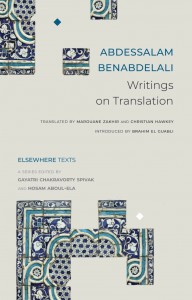
Writings on Translation by Abdessalam Benabdelali, translated from the Arabic by Marouane Zakhir and Christian Hawkey, Seagull Books, 2025
Review by Jordan Silversmith
“What is at stake in translation,” Moroccan philosopher Abdessalam Benabdelali writes, “is the strangeness of the other.” In Writings on Translation, a slim but resonant volume translated with clarity and philosophical sensitivity by Marouane Zakhir and Christian Hawkey, Benabdelali argues not only that translation is foundational to the development of Arabic and European thought, but that it constitutes a mode of ethical relation—a hosting of the stranger.
Composed of essays selected from two earlier Arabic-language works, this collection positions translation not as the failed transfer of meaning between stable tongues, but as a generative rupture in the myth of linguistic purity. Echoing Derrida and drawing on classical Arabic poetics, Benabdelali deftly critiques the nationalist drive to see language as a closed identity. “The instrument of translation is a living language,” he writes, “and its mirror is condemned to be broken.” It is in this shattering that thought is permitted to migrate.
What emerges then is a meditation on translation as both inheritance and resistance. Benabdelali revisits the Abbasid-era Bayt al-Hikma, critiques 18th-century French Orientalism, and confronts the ambivalence of Arabic literary modernity, where some authors write in expectation of translation while others fear its erasure. His essays resist binary framings of colonizer and colonized, instead advocating for a polyglossic hospitality in which meaning is always provisional and always in motion.
Zakhir and Hawkey’s translation meets this challenge with humility and elegance. Their careful rendering preserves the lyric density of Benabdelali’s prose while allowing his ideas to move fluidly across traditions. The result is not just a welcome addition to the global conversation on translation, but a philosophical act. Writings on Translation does not reflect, it refracts.
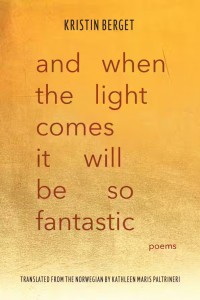
and when the light comes it will be so fantastic by Kristin Berget, translated from the Norwegian by Kathleen Maris Paltrineri, Curbstone Books, 2025
Review by Kaelie Giffel
The first of Kristin Berget’s works to be translated into English, the poetry collection and when the light comes it will be so fantastic traces the metaphorical and physical connections between the earth and the human body. With the current climate crisis haunting the book, the ethical stakes could not be clearer or higher—but this is not a collection, as you can tell from the title, that is solely about the catastrophe. Instead, Berget wonders what we might find when humanity is forced to “crawl down from our viewpoint of the world,” one in which the belief of human superiority is destroying the planet.
Each section is structured a bit differently and, as a result, each takes a different focus. While one section meditates on the failures of human infrastructure, the next considers nature as agent, and the collection ends with a series of questions that morally implicate the reader in the ongoing process of climate change. Rather than an exhaustive catalog of destruction and losses, Berget’s aesthetic project is unique in its attempt to glimpse potential rebirth from destruction. In a poem that condenses the recurring metaphors of broken bodies, sleep, and darkness—which ironically describe modernity rather than its forebears—we receive the titular line: “and when the light comes it will be so fantastic” (emphasis original). At this point, this isn’t naive optimism or a saccharine hope, but an acknowledgement that our current world does not exhaust human possibility. There might be something better, after.
Berget consistently blurs the lines between the human and natural, establishing the stakes to make climate change legible on a human level, as opposed to its more common incarnation in vast and abstract terms. I was initially skeptical of the collection’s seemingly easy movement between the human body, culture, nature, and the earth, questioning what distinguished it as poetry instead of a polemic. However, taken as a whole, the emotional resonance of Berget’s verse far outstrips any argumentative essay on the subject. Poetry, working by way of association and shocking comparisons, acts on us as readers, encouraging an emotive response. I cannot explain why, but the line “Tears simulate both / sea and grief / breath a wind” stopped me in my tracks, its surprising observation reminding me that I, too, am of nature.
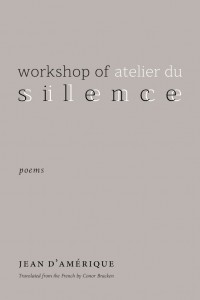
Workshop of Silence by Jean D’Amérique, translated from the French by Conor Bracken, Vanderbilt University Press, 2025
Review by Jordan Silversmith
What remains after the explosion? Jean D’Amérique’s Workshop of Silence walks through Port-au-Prince not with a pen, but with a tuning fork held to the rubble. These poems—which Conor Bracken translates with aching lyricism and precision—stage silence not as absence, but as pressure, ghost, and residue. Here, language arises “in the soot,” each stanza a gesture of salvage from the aftermath.
Born in Côte-de-Fer in 1994, D’Amérique is part of a generation of Haitian poets for whom the disasters—natural, political, colonial—are neither metaphor nor backdrop but elemental. Yet his poems never settle for testimony. Workshop of Silence is a book of spells and scars, where silence itself becomes the workshop in which the imagination re-forges history. “My country is an open wound,” one poem declares. “I write from the place of its bandage.”
The collection is steeped in the sonic traditions of Caribbean poetry—propulsive, incantatory, at times liturgical. But unlike Aimé Césaire’s declamations or Frankétienne’s cacophonies, D’Amérique carves out space for quiet ruin, for “a voice that cries with its mouth closed.” Even the most explosive images, like the “cyclones of broken glass,” the “grave of sugarcane smoke,” are anchored in restraint. Bracken’s English allows this tension to persist: he opts for clean lines, letting D’Amérique’s metaphors seethe without excess ornament.
The result is a book of verse that neither exoticizes Haiti’s crises nor reduces them to political slogan. Instead, D’Amérique offers a lyric documentary of aftermath where love and grief, fire and silence, all occupy the same scarred breath. The body is subject, site, and witness: “my throat / is a burnt city,” he writes.
There is no redemption arc, no final reconstruction—but there is beauty: fragile, volatile, essential. Workshop of Silence does what its title promises; it builds something in the hush after detonation. Poem by poem, here is a testament not only to survival, but to the stunned and stubborn work of beginning again, ex nihilo.
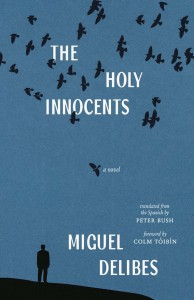
The Holy Innocents by Miguel Delibes, translated from the Spanish by Peter Bush, Yale University Press, 2025
Review by Anna Mebel
Miguel Delibes’s The Holy Innocents is a classic of Franco-era Spanish literature, now finally arriving in English through Peter Bush’s translation. As detailed by Colm Toíbín’s generous foreword, the political repression of the Franco regime, coupled with a vibrant literary culture, created a generation of Spanish novelists who used formal innovation to skirt censorship—Delibes being amongst them.
On its face, The Holy Innocents reads as a fable, restrained in explicating its characters’ motivations while carefully building a condemnation of the wealthy, portraying their monstrous callousness and the peasants’ abject poverty. In Delibes’s evocation, the peasants and the landlords exist almost outside of time in semi-feudal, practically medieval conditions, with the illusion punctured occasionally with references to airplanes, Land Rovers, and zippered leather jackets. While the laborers are illiterate, live in poverty in cramped houses, the landed gentry—addressed by the peasants as señioritos—carouse, flirt, and hunt without a thought in the world. In a characteristic turn, Señiorito Ivan, perhaps the most dastardly of them all, scoffs at a servant girl’s desire to take First Communion: “. . . they’re saying they should be treated as people, and that’s just ridiculous, you see that with your own eyes, but they’re not to blame, the blasted [Vatican] Council is to blame for sowing unrest.” Delibes also constructs disparities in other ways; the peasants are valued more for their animal qualities and less as humans—like the game warden Shorty Paco for his keen sense of smell.
Despite an unconventional style that eschews straightforward realism, the characters of the novel feel exceedingly vivid—the brilliant daughter who is resigned to be a servant girl; the callous, hunting-obsessed noblemen; or the unforgettable Azarías, a deranged man who takes cares of animals, skipping from eleven to forty-three when he counts. Azarías is one of the holy innocents of the title—a gamekeeper in his sixties who is described as simple by his family and mocked by the landowners, but who has an extraordinary sensitivity to animals, which allows him to tame birds. He talks to each creature, addressing each as “pretty kitey” (an invention of Bush’s, modulated from the more literal translation of “kite” to make Azarías’s repetitions more musical), and the birds respond with equal affection.
Class rage simmers over the course of the novel and finally explodes in the novel’s climactic finale, driven by Azarías’s subconscious desire for justice. With a righteous violence reverberating long after the novel ends, The Holy Innocents is a powerful tale of the essential struggle for human dignity, one that resonates with the regime changes of its author’s time—as well as those of our own.
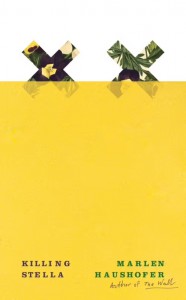
Killing Stella by Marlen Haushofer, translated from the German by Shaun Whiteside, New Directions, 2025
Review by Kaelie Giffel
Killing Stella, a disturbing novella by the Austrian writer Marlen Haushofer, explores the everyday horror of the heterosexual family, its violence, and the perversion of its relationships. Through it, Haushofer puts Freud to shame. When Anna, the narrator, is alone for two days while her husband and children are away, she writes the story of Stella, a young woman once living with the family, who one day stepped in front of a yellow bus in a red dress and died. In reconstructing the events leading to this moment, Anna describes how Stella had been slowly destroyed by Richard, Anna’s husband—and how she herself had never lifted a finger to help, for to do so would’ve jeopardized her precarious position as housewife. Needless to say, there is no solidarity to be had here.
Haushofer’s ruminating, compulsive style is both formally and thematically appropriate for the guilty and anguished thoughts of a woman over the course of two days. In that time, Anna tells us of Stella’s death, but in doing so, she finds, forgets, and rediscovers the truth of her own complicity. Shaun Whiteside’s translation captures Anna’s obsessive, circular, and oblique thinking, though there are occasional missteps in the prose (Stella is observed “gazing convulsively” into a cup, which isn’t physically possible). This disjointed quality to the narration moves from shocking moments of violence or self-awareness before quickly shifting into seemingly unrelated events, and ultimately, the jagged shape of Anna’s thought enacts the grim realization there might be things we would rather not see, rather not admit, about ourselves.
The book’s primary question is this: Is ignorance really the primary obstacle to freedom, individual or collective? Can telling or knowing the truth set you free? The book’s answer is a resounding no. Anna thinks: “But horror and the knowledge of the truth that one is not supposed to know belong to the order of everyday life. . . I love that order, which allows me to live.” Despite the fact that she isn’t supposed to know about the violence at the heart of the family, she does. It fails to move her anyway. In this, Anna poses a problem for the feminist reader who thinks all that we need to overthrow patriarchy is a good round of consciousness-raising. She’s fully aware of the violence that makes her life possible—she just can’t imagine living outside of it.
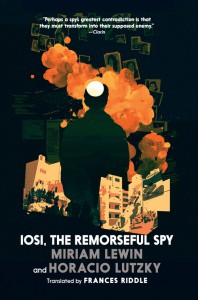
Iosi, The Remorseful Spy by Miriam Lewin and Horacio Lutzky, translated from the Spanish by Francis Riddle, Seven Stories Press, 2025
Review by Kaelie Giffel
In Iosi, the Remorseful Spy, there are competing interpretations of the antisemitic bombings in 1990s Argentina—and even if at its conclusion, I’m still not sure which to believe, the book is a welcome contribution to a transnational assessment of antisemitism and the lingering effect of Nazism around the world. The story follows the titular Iosi, who comes to two Argentinian Jewish journalists, Miriam Lewin and Horacio Lutzky, with a large tale. Iosi had been placed undercover in an Argentinian Jewish community when the state believed in a Jewish conspiracy to take over the country, and during the few years that he’s on the job, two devastating bombings in 1992 and 1994 cause him to believe that the information he was feeding to his superiors had been directly used to plan those attacks. What follows is a mindbending account of multiple competing secret services and federal agencies; by the end, there seem to be more questions than there are answers.
Formally, the book resembles a dossier, with several parts and short, titled sections. This choice creates a quick, thriller-esque pace—though one that is not quite reflected in the plot and its relatively flat narration, with a tedium of acronyms also slowing down a quick reading. The authors, interestingly, decline to sensationalize events in favor of a mostly linear presenting of facts, and the switching of perspectives between Iosi, Lewin, and Lutzky reveal the different stakes in place for each of them. The most compelling bit of narration happens in the sections in which the journalists’ voices take center stage, as they occupy a position a bit closer to the reader; they have to evaluate the truth of Iosi’s testimony—and what they’re supposed to do with it. In many ways, the book felt a bit like reading The Crying of Lot 49. (Except, in this case, postmodernism doesn’t derive from the author’s aesthetic, but the state’s politics.)
Lewin and Lutzky also have to consider their own safety. Iosi arrived in their lives in 2002, nearly twenty years after the ending of Argentina’s military dictatorship, yet they still found themselves pitted against the well-known Nazi sympathies of the Argentine police force and the government’s secret police agencies. As such, their illumination and criticism of repressive state apparatuses exemplify their committed journalistic talents as they unearth the unsettling connections and similarities between Argentina, the United States, and Israel. In exposing the secrecy of the Argentinian police, the book calls into question the practice of nations calling themselves democracies while operating secretive police forces domestically and internationally. One gets the sense that this little book is outmatched by its opponents. What force can truth exert against these Goliaths?

I Found Myself. . . The Last Dreams by Naguib Mahfouz, translated from the Arabic by Hisham Matar, with photographs by Diana Matar, New Directions, 2025
Review by Jason Gordy Walker
In 1994, the Egyptian Nobel laureate Naguib Mahfouz—author of countless novels, stories, articles, and plays—opened a car window to greet a young man, who then stabbed him in the neck; Mahfouz had been declared an infidel by the “Blind Sheikh,” Omar Abdel-Rahman, for writing The Children of the Alley, a novel that retells the foundational narratives of Abrahamic scriptures. The soft-spoken Cairene survived—he even forgave the assailant—but he suffered nerve damage. He would never complete another novel, but continued to be a writer through dictation, composing a series of very short stories based on his dreams. Translated gracefully by Hisham Matar and accompanied by Diana Matar’s enigmatic photographs, a selection of these late works constitute I Found Myself. . ., revealing a man haunted by desire, regret, and, surprisingly, hope. Poetic in their concision, existential and tender, their reverberating tone of wistfulness links together a recurring cast of characters, both personal and political.
Conversations around dreams generally result in boredom, but Mahfouz’s retellings have the effect of a captivating film. Often beginning with “I found myself” or “I saw myself,” the brief sketches keep their readers aware of the I-behind-the-I, producing an off-kilter sensation that blurs dream and reality, with constant crossings between the two worlds. In one dream, the author finds himself face to face with President Jamal Abdel Nasser, who says, “You may be asking why we don’t meet as often anymore”; in another, Mahfouz sees himself reading the autobiography of Saad Zaghloul and later finds that his wife has given birth to twins. A recurring figure is the writer’s “darling B.”—a beloved, mysterious like Dante’s Beatrice:
I found myself in the local wedding photographer’s studio. Among the gallery of photographs, I spotted B. I examined her picture closely [. . .] enduring desperate regrets, and yet recognizing that I had not lost hope completely, and gleaning some solace from that fact.
There is much that intrigues in these dreams, but Mahfouz cannot quite get his mind off of lost love, and his romantic obsessions enchant because they are truly romantic, not merely escapist. His enduring love for B.—as authentic as his affection for Cairo’s people, their neighborhoods, and cafes—grounds his dreams in reality. Hisham Matar says in his touching introduction, “[B.] comes to embody both a painful longing as well as a hope, as though in approaching death he is coming nearer to her.” She may not be with him in waking life, but she is as real as anyone, and Matar’s exemplary translations showcase Mahfouz in these most refined, melancholic phases—equal parts yearning, uncertainty, and joy.
Juxtaposed seamlessly with the stories, the noirish pictures of Diana Matar heighten the book’s intimacy with scenes of daily life in modern-day Cairo: a dapper, suited man, who has just walked down a staircase, quickly looks to his right; a dark figure gazes across the Nile; policemen and security agents go about their shady business. Together with Mahfouz’s warm voice and subconscious visions, the effect is one of compassion and a wise understanding of life’s difficulties. I was swayed to lose myself in their bittersweet zones, as if I were not reading, but lucid dreaming.
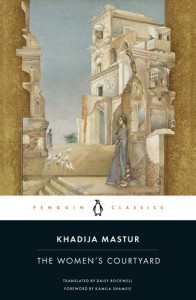
The Women’s Courtyard by Khadija Matsur, translated from the Urdu by Daisy Rockwell, Penguin Classics, 2025
Review by Kaelie Giffel
Khadija Matsur’s The Women’s Courtyard obliquely narrates the long, complex tale of Partition—the division between India and Pakistan in the 1940s—through the life of a girl named Aliya. As a bildungsroman, the novel traces her life from her family confines toward education, independence, and the wider world, roughly corresponding with the political unrest that builds over the years leading up to Partition. The inciting incident is the arrest of Aliya’s father for political speech, but the focus remains on the private world of Aliya’s family, the constraints that women face, and the violence of the family as a social form. Daisy Rockwell’s new translation is crisp and compelling, with a translator’s note that contextualizes Matsur’s novel and shows its unique approach to Partition within Indian literary history.
Matsur’s work is staunchly feminist and makes an important contribution to transnational critiques of the family and marriage as institutions. Given the growth of family abolition literature in the last five years, feminists have much to gain from such a novel. For example, Matsur’s depiction of the family is withering; not only are women relegated to limited spaces within their homes, they are also emotionally and psychically starved. Aliya’s mother is depicted as a stereotypical nag and a patriarchal woman who takes full pleasure in diminishing others to bolster her own social position—but the depiction is made with the full knowledge that societal forces have shaped her into the miserable woman she is, underscoring her cramped existence. Aliya’s sister, too, subsists on romance novels that Aliya suspects ultimately lead her to commit suicide. Overall, The Women’s Courtyard makes it clear: if Aliya is to survive her milieu, marriage or men cannot be part of the picture.
The pervasive misogyny of Aliya’s world is all too clear in the stories of other women told throughout, for whom love was to be an escape from the oppressive bindings of family. (Except they only ever seem to find themselves further oppressed, if not dead.) These stories are intended as instructive, moral tales by which Aliya is meant to learn the behaviors that her mother dictates—but instead, they enable Aliyah to make a true break from her mother, emotionally and psychically, when she refuses to ruin her life for not one, but two “sensible” marriages. When we see Aliya come into her own, it is something of a relief. Her life is a new possibility alongside all the many tales that have no room for women’s happiness or independence.
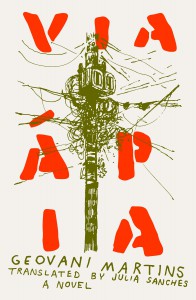
Via Ápia by Geovani Martins, translated from the Portuguese by Julia Sanches, FSG Originals, 2025
Review by Anna Mebel
What is the biggest complaint during a police takeover? The lack of good weed. At least, that’s what Geovani Martins shows us in his novel Via Ápia, set in Brazil’s most populous favela, Rocinha, located in the South Zone of Rio de Janeiro. In 2011, the Unidade de Polícia Pacificadora (UPP) occupied the neighborhood in anticipation of the country hosting the 2014 World Cup, wreaking havoc on the routines of its inhabitants; translated in a slangy, rhythmic style by Julia Sanches, Martins’s novel recounts the goings-on in two neighboring apartments before, during, and after the UPP occupation: the first is that of a mother and her two sons, Washington and Wesley, who both work service jobs; and the second is home to roommates Douglas (burgeoning tattoo artist), Biel (burgeoning drug dealer), and Murilo (reluctant soldier).
Via Ápia is appealingly shaggy. We see the characters work their survival jobs, get high, get drunk, get tattoos, play video games, compete in impromptu ping-pong matches with a makeshift table and ball, and dance, as the prose moves loosely and in short bursts between the five major characters. The night before the UPP raid, the characters race to smoke all the weed in their apartment, and once the occupation is in place, the sense of dread is conveyed through atmosphere and periodic outbursts of violence; the police beat up Murilo for not carrying his identification card, and one character meets a tragic death. Then, when the forces finally withdraw, they leave the neighbors with the same infrastructural failures like blackouts and the lack of hot water. Their lives are the same—but now they resort to smoking bad weed, because of the crackdown on the neighborhood’s drug dealers. Through a focus on the local conditions, Martins indicts a country that treats its poor and Black citizens as a problem to be resolved by brutal “pacification,” while still celebrating the lively, joyful pulse of life in Rocinha.
Though the novel struggles at times to differentiate its characters, it excels at capturing these intimate rhythms of everyday life. What emerges is a portrait of a community, rather than specific individuals. In a BOMB interview with his translator Julia Sanches, Martins defines his project as emphasizing the marginalized: “If a large group of people live in a community, where they have relationships of affection, where they work and produce things—it’s hard to accept that this is the periphery, and that the center is far away.”
Despite the indignity and violence the characters of Via Ápia endure at the hands of the UPP, the novel ends with an affirmation of life. The surviving friends reunited on the dance floor, the beat coming on, and the force of life—“always life, never death”—making the ground shake.

All the Lights by Clemens Meyer, translated from the German by Katy Derbyshire, And Other Stories, 2025
Review by Anna Mebel
Through spare and haunting prose, Clemens Meyer’s short story collection All the Lights depicts the lives of lonely, marginal characters in Eastern Germany: a cast that includes ex-cons, boxers, forklift drivers, and a schoolteacher inappropriately in love with his student. Meyer’s protagonists pace around the industrial streets, drink in snack bars, waiting for money and jobs, either unemployed or crushed by the grueling demands of work, as their shaky hold on reality blends one scene into the next, memories bleeding over into the present.
What makes the stories in All the Lights compelling is Meyer’s modernist flair in rendering consciousness as slippery and imagistic, a style translated aptly by Katy Derbyshire. The opening story “Little Death” is written in present tense but blurs the distinction with the past, moving between scenes associatively, using iterative images like cigarette smoke and the train outside the narrator’s apartment window. Only at the end do we realize that the character’s girlfriend has left him, and he has been kicked out of his apartment, rendered homeless. Clemens’s precise, pared-down sentences are aimed at representing consciousness and, thus, aren’t afraid to dip into phantasmagoria; in “The Short Happy life of Johannes Vetterman,” the dying owner of a fruit distribution company sees a man with a dog’s head in his hotel room, and imagines his life as a series of paintings he never made.
The narratives themselves are often relentlessly bleak. In “Of Dogs and Horses,” Rolf, likewise unemployed, gambles at a racetrack to secure funds for a hip surgery that would save his dog’s life. The horses have beautiful names—Planet Pony, Dream Believer, and Lonely Affair—and he is hopeful, relying on beginner’s luck. Eventually, he wins big, but, as he walks home with pockets stuffed with winnings, he is unaware of the three men following him.
Clemens’s commitment to portraying the dashed hopes of working-class life is admirable, but the best stories transcended the characters’ drab existence. In “Waiting for South America,” an unemployed man gets a taste for adventure and tequila by reading his friend’s lively letters from South America. Whether the letters are actually being written from the exotic locales or not, they awaken boyhood dreams in their reader: “Remember how we used to dream of Brazil? Pelé, the great Pelé. The white Sugarloaf Mountain and the girls on the beach, remember that?”
Notably, the collection probes masculinity and finds grace in the friendships between men. In “Riding the Rail,” the narrator and Blondie are ex-cons who share a taciturn, off-kilter friendship that transcends their mutual awkwardness. Only one story in All the Lights is told from a woman’s point of view, while in the rest of the collection, they function primarily as objects of desire, their beautiful hair as illusory as the shining lights of the cities that the men yearn for.
Ultimately, Clemens brings us a world of lonely people, like the boxer who’s obsessed with his win-loss-draw ratio. The losses outnumber the wins, but the dreamers remain thinking of a better life.
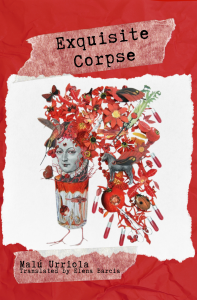
Exquisite Corpse, by Malú Urriola, translated from the Spanish by Elena Barcia, Unsolicited Press, 2025
Review by Jordan Silversmith
“There is a woman with a shattered eye,” Malú Urriola writes. “She is the corpse of language.” In Exquisite Corpse, the final book by one of Chile’s fiercest and most unsparing poets, Urriola confronts the wreckage of personal and collective trauma with a voice that shatters the decorum of verse. Translated with taut precision by Elena Barcia, this collection reads like a scorched postscript to the antipoetry of Nicanor Parra, who dismantled the Western lyrical tradition with his wit and irreverence. Urriola, by contrast, writes with the urgency of someone carving a record into stone: “in the middle of the road, against the night, I leave my trace.”
Like Parra, Urriola wields fragmentation, irony, and black humor as weapons against complacency. But her project is not simply to unmake poetry; it is to expose the social corpse beneath its surface. Many poems unfold like forensic reports or public testimonies: a school shooter’s diary, a police report, a litany of names erased by state violence. Others simmer with surrealist energy, channeling the grotesque through a feminist and decolonial lens. “They killed a child and now they want a poem,” she writes. “I give them this: an eye in a box.”
In Barcia’s translation, the rhythm and abrasion of Urriola’s Spanish is preserved without softening, a lucid voice at times terrifying in its restraint, always aware of the stakes: “This is not metaphor. This is what happened.” In this, her poetic sensibility resists transcendence. Like the collage method invoked by the title, her work pieces together the fragments history leaves behind—shoes, blood, the official report—with a gaze that refuses to look away. This is poetry not of closure but of exposure, and in that exposure, there is a furious kind of clarity.
Kaelie Giffel regularly publishes essays and reviews about feminist literature and politics, focusing on works in translation. Her first book, University For a Good Woman, is out from Lived Places Publishing and uses the memoir form to interrogate class and misogyny in an American university. She holds a PhD from University of Washington where she studied feminist world literature. You can find more of her work at kaeliegiffel.com.
Anna Mebel holds an MFA from Syracuse University. Her writing has received support from the Vermont Studio Center and has appeared or is forthcoming in The Iowa Review, Gulf Coast, Wigleaf, and elsewhere. She is currently at work on a novel.
Jordan Silversmith is the author of Redshift, Blueshift, winner of the 2020 Gival Press Novel Prize, and his poem, “Praxis,” has received the 2020 Slippery Elm Prize in Poetry. He regularly writes on literature in translation.
Jason Gordy Walker is a poet, translator, and prose writer. His translations of poems from the Norwegian of Rune Christiansen are forthcoming at B O D Y (Czech Republic) and Cordite Poetry Review (Australia). Walker was the February 2025 Artist-in-Residence at Newnan ArtRez in Georgia, U.S.
*****
Read more on the Asymptote blog:

